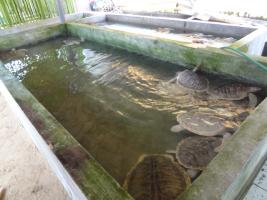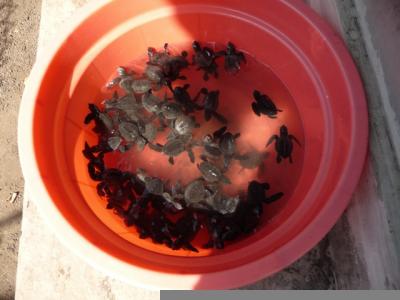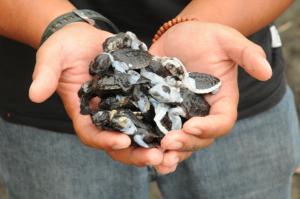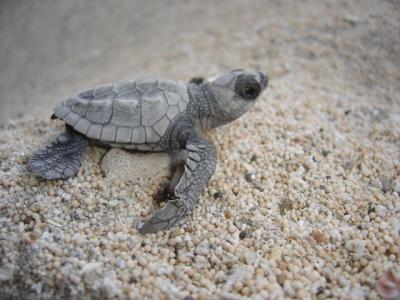Sea Turtle Headstarting: Conservation’s Fishy Business
All sea turtle species are threatened with extinction. They are also protected by national and international laws, which makes it important to pay serious attention to their conservation. However, human seems to be addicted to nature exploitation, including towards this poor creature. People try many ways to find loopholes in the laws, just to be able to make use of sea turtle for their own good. In many places, sea turtle populations have declined so severely due to overexploitation done in the name of conservation.
Before the 2000s, sea turtle was widely traded for its meat, eggs, and shell. When the law authorities began to work on better control and confiscation of traded sea turtle and its products, today this illicit practice has moved to a new mode. So sophisticated is the mode that lay people would be misled.
This new mode is called "Sea Turtle Farming" and "Sea Turtle Headstarting". Sound adorable, right? Many of the general public, government, and tourists have mistaken these practices for conservation.
Sea Turtle Farming
 Sea turtle farming is basically an effort to raise sea turtles for commercial purposes: show them to visitors, cultivate their meat, and sell them as pets. In a farm in Indonesia, they do some kind of "sea turtle laundry", that is buying sea turtles captured from the ocean to be made as tourist attraction. Tourist may touch the sea turtle, even sit on top of it and take pictures!
Sea turtle farming is basically an effort to raise sea turtles for commercial purposes: show them to visitors, cultivate their meat, and sell them as pets. In a farm in Indonesia, they do some kind of "sea turtle laundry", that is buying sea turtles captured from the ocean to be made as tourist attraction. Tourist may touch the sea turtle, even sit on top of it and take pictures!
When feeling stressed, sea turtle tends to stay still and will not struggle although people disturb it. When a particular sea turtle has been out in the show for too long, most likely it will be slaughtered for the meat. Another "fresh" sea turtle will take its place. The lack of control from the law authories makes such unethical practice seem "invisible".
Headstarting
Headstarting is a technical term for raising sea turtles until they reach particular age or size, then release them to the ocean in hope that they will have a greater chance to survive. In a glance, this practice seems compassionate and fruitful, but it disregards the natural life cycle of sea turtle. Though not as bad as sea turtle farming, headstarting is still not acceptable in terms of conservation for there is no proof that it works. Headstarting is regarded to be too risky. Here is why:
 Sea turtle is a unique animal with a sophisticated life cycle, which is unknown to most people. Since they come out of their eggs, the babies have to go through a series of process that they have to pass to train their natural instinct, so that they can live independently, survive, and multiply.
Sea turtle is a unique animal with a sophisticated life cycle, which is unknown to most people. Since they come out of their eggs, the babies have to go through a series of process that they have to pass to train their natural instinct, so that they can live independently, survive, and multiply.
Hatchlings must reach the ocean as soon as they come out from under the sands, to avoid predators like dogs, cats, lizards, eagles, sharks, octopuses, and many more. Experts claim that only 1 out of 1000 hatchlings will survive reaching its adult age. In the process of getting to the water, the hatchlings employ all their senses to record the environment, so when they grow up and it is time for the females to lay their eggs they could return to the shore where they hatched.
Getting in the waters does not mean that they are over the dangers. They will encounter strong currents that they are unable to swim againts. They will be forced to float off with the current, which means they can rest because they do not have to swim. Every hatchling has yolk on their belly, which act as their temporary food provision. This yolk can last for approximately 3 days. When they are running out of the yolk, they will start eating their natural diets.
This period of floating off with the current is called the lost years. Hatchlings will remain in this state while growing up, until they return to the place where they got to the water for the first time. By this time, they will have become adult sea turtles (35-40 years), and then they will mate and the females will lay their eggs in that very shore for 3-7 time per nesting period. Two months later, new hatchlings are going to emerge from under the sands, and the cycle begins again.
Headstarting is conducted based on the premise that if the sea turtles are released when they are big enough, it could curb the chance of them being eaten by predators. Alas, no research have ever proven that this is true. There was a massive long-term research project conducted in Florida, US, by the Department of Nature Resource. The project lasted for 30 years, involving 18.000 sea turtle babies. Started in 1958, this project was finally terminated in 1988 because no useful findings were obtained, nor could it prove that headstarted sea turtles have better chance to become adults and reproduce.
Not only failed, the research had also cost heaps of money because to raise that many sea turtles properly, the researchers had to provide the facilities, accommodation, and food as close as possible to their natural environment. It means that a huge vessel, or perhaps a modified bay, is needed along with sufficient food supply. This surely take a lot of works and funding.
Meanwhile, headstarting activities in Indonesia cannot actually be considered as "headstarting" as the process and steps are not correctly followed, and many of them do not have any scientific purpose at all. It is all about business.
Headstarting Problems in Indonesia
 Sea turtle headstarting in Indonesia is a malicious activity because it is always carried out with minimum budget in ordet to reap big profit. The problems include:
Sea turtle headstarting in Indonesia is a malicious activity because it is always carried out with minimum budget in ordet to reap big profit. The problems include:
- The pools or vessels provided are too shallow, while sea turtle babies need to exercise accordingly to develop their lungs
- In some places, donors help the "breeders" by providing deep pools, but due to the seemingly expensive electricity and water pump cost, they only fill a quarter or even a tenth of the pool's depth.
- Breeders do not apply medical treatment for the sick sea turtles, so that a lot of them die. among the common diseases are fungus, bacteria, and protozoa. These are all caused by dirty water.
- To "please the guests", bredders often allow the visitors to touch and play with the hatchlings. This is actually stressful for the hatchlings.
- To remain simple and uncostly, hatchlings are fed with minced dead fish. This could kill their instinct to actively search for their natural diets, and the leftover will trigger diseases in the pool.
- Naturally, sea turtle is a solitary animal, means that each individual does not work with others in finding food, protecting itself, and surviving. Meanwhile, in headstarting facilities, they are put together in a pool, in high density and interaction. This is prone to stress the sea turtles and trigger cannibalism.
Considering all those problems, many negative impacts for sea turtles might be provoked by headstarting, for instance:
- Hatchlings fail to recognize their natural diet, and lost the ability to search for food because they havee become used to be fed by human for too long. There have been many cases where headstarted hatchlings returned to the shore in severe condition a few days after they were released to the ocean. Most possibly that they failed to adapt to their natural environment.
- Being overly dependent to human, sea turtles often going around in circle not far from the shore, waiting for human or fishermen boats hoping to be fed. Wicked fishermen would catch the sea turtle to be made as bait for big fish.
- Sea turtles cannot live their natural cycle, therefore they cannot play their role in the ecosystem.
Thus, it is clear to see that sea turtle farming and headstarting have no benefit except for the exploitators. Conservation efforts are best carried out in as natural ways as possible. In Indonesia, headstarting practice has become obscure, and can be easily confused with sea turtle farming which is done solely to get financial profit. The sea turtle's welfare and sustainability are less important.
What can you do?
Sea turtle farming and headstarting are profit-oriented mischievous business, and against conservation efforts. Those are exploitation in conservation mask. If you really care about sea turtle, you can help in simple and cheap ways such as:
- Do not visit tourism sites that conduct sea turtle farming or headstarting
- Do not donate to such place, for they have violated animal welfare ethics
- Report to PROFAUNA whenever you run into this kind of practice. Send us e-mails to: international@profauna.net

